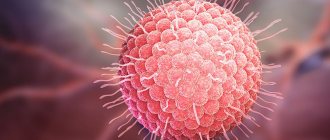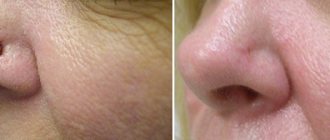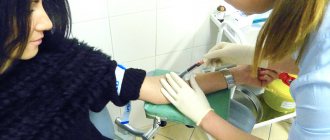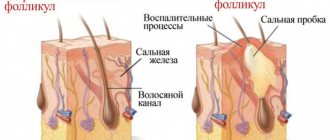The human immune system protects the body from the penetration of pathogenic bacteria and harmful substances. But sometimes she reacts inappropriately to eating certain foods, such as fish or seafood. An allergy to them can appear at any age, but it poses the greatest danger to young children and pregnant women - their body is subjected to serious stress and may not cope with the manifestations of the disease.
What causes fish allergies?
The immune response to the penetration of an allergen into the body is the production of specific substances (antibodies). These compounds are released into the blood and distributed throughout the body. They are then absorbed into the area of connective tissue that has the greatest contact with the allergen. In response, histamine is released from mast cells. It causes spasm of smooth muscles, lowers blood pressure and reduces the permeability of blood vessels. Stagnation of blood leads to swelling and thickening of the blood. This is why an allergy sufferer experiences itching, burning, red spots on the skin and difficulty breathing.
Seafood contains a large number of chemical compounds that are poorly tolerated by the human body. For example, alpha or beta parvalbumin is a specific calcium-binding protein. The first is present in the meat of amphibians and cartilaginous fish, the other in the muscles of bony fish. They are not destroyed during cooking, so an allergic reaction can occur even after an allergic person eats from a container in which fish was previously cooked.
Allergens can accumulate in meat while the fish is in the pond.
These include:
- pesticides, products and waste from the chemical industry;
- antibiotics;
- growth stimulants and feed.
Improper storage of fish negatively affects its quality. It accumulates a toxic substance (scombrotoxin), which is a strong allergen. It is resistant to any type of processing.
When preparing canned food and preserves, preservatives, spices and sauces are added to fish meat. Their composition is extensive, so this food can cause an inadequate reaction in the immune system.
Like any other living organism, parasites live in fish and seafood. Their protein and waste products, when entering the human body, can also trigger allergies.
Which fish most often causes allergies?
Allergies can be selective, that is, they can occur to specific types of fish. Most often, these are red fish containing alpha-parvalbumin. Eating herring, pollock, seal or sprat is safe in this case.
The first place among allergens is given to predatory fish. Their meat accumulates harmful substances in large quantities, and they are more susceptible to helminthic infestations.
The degree of allergenicity of fish and seafood in the table
Environmental pollution due to human activities has left its mark on the quality of fish. Harmful substances used in the petrochemical and light industries flow into its habitats, which subsequently accumulate in meat.
The degree of allergenicity of fish and seafood is presented in the table.
| Fish genus | high | average | low |
| Tuna | + | ||
| Pink salmon | + | ||
| Sardines | + | ||
| Salmon | + | ||
| Herring | + | ||
| Mackerel | + | ||
| Halibut | + | ||
| Hake | + | ||
| Zander | + | ||
| Acne | + | ||
| Som | + | ||
| Carp | + | ||
| Mussels | + | ||
| Oysters | + | ||
| Squid | + | ||
| Crustaceans | + |
Artificial cultivation of fish involves the use of antibiotics, feed and growth hormones. The larger and older the individual, the more immune irritants it contains.
What types of fish can be given to infants and which cannot?
Doctors recommend starting fish feeding with low-fat marine varieties: rivers are more polluted than seas and oceans, so river fish absorbs more toxins. But freshwater inhabitants are not prohibited either; you can try cooking trout, pike or pike perch for your child.
Protein and fat content in fresh fish - table
| Type of fish | Per 100 g | Per serving (200 g) | ||
| squirrels | fats | squirrels | fats | |
| Tuna | 24,4 | 4,6 | 48,8 | 9,2 |
| Sea trout | 21 | 7 | 42 | 14 |
| River trout | 21 | 5 | 42 | 10 |
| Pink salmon | 20,5 | 6,5 | 41 | 13 |
| Salmon | 20 | 13 | 40 | 26 |
| tilapia | 20 | 2 | 40 | 2 |
| Pollock | 19,9 | 0,9 | 39,8 | 1,8 |
| Flounder | 19,7 | 3 | 39,4 | 6 |
| River perch | 18,5 | 0,9 | 37 | 1,8 |
| Zander | 18,4 | 1,1 | 36,8 | 2,2 |
| Pike | 18,4 | 1,1 | 36,8 | 2,2 |
| Sea bass | 18,2 | 3,3 | 36,4 | 6,6 |
| Mackerel | 18 | 14 | 36 | 28 |
| Bream | 17,1 | 4,4 | 34,2 | 8,8 |
| Hake | 16,6 | 2,2 | 33,2 | 4,4 |
| Cod | 16 | 0,6 | 32 | 1,2 |
| Carp | 16 | 5,3 | 32 | 10,6 |
Ready-made fish puree
Fish purees along with vegetables are available for sale from various baby food manufacturers. If you have doubts about the quality of the fish being sold, it is better to buy ready-made fish that have been certified and approved for consumption by infants.
If you decide to cook fish yourself, be sure to check the quality of the product, ask the sellers for certificates and sanitary and epidemiological reports, because the health of your baby depends on this. Pediatricians recommend buying fresh product; frozen fillets contain fewer vitamins and minerals.
Fish purees from different manufacturers - photo gallery
Heinz Fish Purees are suitable for children aged 8 months and older.
Fish purees Babushkino Lukoshko are intended for children from 8 months
Fish puree Sami with mustache is intended for children from 8 months
Fish and chips and fish with vegetables from Hipp for babies from 8 months
Noodles with sea fish and vegetables in creamy sauce from Hipp for babies from 9 months
Pasta with sea fish and vegetables in tomato sauce from Hipp for babies from 12 months
Fish puree Semper for children from 9, 10 and 11 months
Fish purees Semper for children from 12 months
Fish purees Semper for children from 18 months
At-risk groups
An allergy to fish or seafood protein can develop at any time. This usually occurs during periods of strong emotional stress, exacerbation of chronic diseases, and pregnancy. In childhood, it occurs due to an imperfect immune system.
The risk of developing allergies increases due to exposure to the following factors:
- heredity;
- predisposition to allergic reactions of any type;
- weakened immunity;
- severe pollution of water bodies;
- proximity of catch sites to light and petrochemical industry enterprises.
It has been noticed that allergies most often appear after eating unusual food - if a person lives on the sea coast, then he may have intolerance to the protein of river fish and, vice versa.
Types of allergic reaction
Contact with an allergen can cause different reactions in the body:
- Anaphylactic IgE-mediated (local). Occurs immediately after the interaction of antigen with antibodies. It is expressed in the appearance of allergy symptoms in the area of the body that has been in contact with the provocateur. For example, when inhaling vapors while cooking fish, tearing, rhinitis, suffocation may begin, when cleaning it: urticaria, swelling of the hands.
- Anaphylactic IgE-non-mediated . After contact with an allergen, the immune system begins to attack the entire body through the central nervous system, regardless of the place of contact with the allergen. This condition is life-threatening.
- Cross allergy . It occurs due to an erroneous reaction of the immune system not to the allergen protein, but to another one that is structurally similar.
Common allergy symptoms
Intolerance to fish and seafood protein manifests itself differently in each person.
Its symptoms become noticeable in the most vulnerable areas:
- in the stomach area: flatulence, bloating;
- vomiting, diarrhea;
- skin: itching, burning, urticaria, swelling, eczema;
- respiratory and visual organs: lacrimation, rhinitis;
- swelling of the larynx, suffocation, shortness of breath, cough.
In case of a severe allergic reaction, anaphylactic shock develops: a sharp increase in blood pressure, heart rhythm disturbances, dizziness, spasm of blood vessels, pallor of the skin, loss of consciousness. A person who finds himself in such a situation needs medical attention - death is possible.
Features of the course in children
The introduction of fish into the diet of infants is carried out gradually in order to monitor the body's reaction. This usually occurs between 9-12 months.
However, given that fish allergies are common in children, parents need to be careful. As a rule, they start with half a teaspoon per day - this is enough to observe the body’s reaction. You should not get carried away with taking fish oil to prevent vitamin deficiency - it is a strong allergen.
In infants, fish protein intolerance manifests itself in the following symptoms:
- peeling of the skin;
- red rash on the legs, arms, back, stomach;
- vomit;
- diarrhea.
Because of their appearance, the child becomes irritable, whiny, pulls his legs under him, taking the fetal position. This indicates a disturbance in the digestion process and abdominal pain.
When reacting to the smell and vapors of fish food, sneezing, runny nose, and watery eyes may occur.
A child’s body cannot cope with allergy symptoms on its own; medical attention is needed. When the first symptoms of the disease appear, take antihistamines and cleanse the intestines with adsorbents. During treatment, the allergen is completely excluded from the diet.
Diagnosis
If there is a suspicion of an allergy, a person should make an appointment with an immunologist and allergist.
Doctors will prescribe tests that are carried out in different ways:
- Scratch method. Several scratches are made on the skin with a sterile needle, and the allergen is dropped onto them. If a lesion of more than 2 mm (redness and swelling) appears on the skin, the test is considered positive. Up to 20 samples are made in one place.
- Injection method. This refers to intradermal tests. The solution with the allergen is administered as an injection, then the reaction is assessed.
- Three days before the tests, it is necessary to interrupt the course of taking antihistamines.
If specialists cannot identify the allergen, then they begin to remove highly allergenic foods from the patient’s diet one by one and wait for the body’s reaction.
Allergy symptoms in pregnant women
During the period of bearing a child, a woman’s body is subjected to serious stress. This makes her vulnerable to allergies, including to salted or dried fish and seafood. Therefore, at the first symptoms, you should stop using them for the entire period of pregnancy.
The allergic reaction appears in the form of spots and areas of peeling:
- on the wrists and elbow joints of the hands;
- on the stomach in the navel area.
Allergic rhinitis, conjunctivitis, and lacrimation may be present.
Local antihistamines are used as treatment for pregnant women: ointments, nasal sprays, drops. To neutralize and remove the allergen from the body - adsorbents.
Cross shape
Substances contained in fish provoke allergies upon contact with them in any form.
Parvalbumin is found not only in fish, but also in shellfish, lobsters, crayfish, lobsters, oysters, and shrimp, so a child with parvalbumin intolerance will have a reaction to these foods.
Histidine is found in a wide range of foods, including squid, eggs, wheat, soy, beef, and some types of cheese.
Diagnostic methods
If symptoms of an allergic reaction to fish and seafood appear, you should contact your local physician or pediatrician. He will give you a referral to an allergist. During the appointment, the patient is examined and interviewed.
To clarify the diagnosis, laboratory tests are performed:
- prick test;
- blood test for immunoglobulin E.
The first is a skin test. An area of skin on the forearm is treated with ethanol and drops of histamine, saline solution (zero sample) and allergen are applied at a distance of 2-3 cm. Through them, the skin is punctured with a special needle so that no blood appears. Assess the result after 10-15 minutes. A prick test is considered positive if there is a blister or redness greater than 3 mm in diameter.
Blood test for IgE. The material for research is collected from the ulnar vein in the morning - at this time its concentration reaches its maximum value.
The rules for donating blood do not differ from the procedure for taking a biochemical analysis:
- 2-3 hours before the puncture you should not smoke or use nicotine replacement drugs;
- the day before and during the day it is prohibited to consume alcoholic beverages, drugs, or energy drinks;
- Before the procedure, you can drink only clean, still water.
Blood donation for IgE levels is carried out only after 2 weeks of drug withdrawal.
Causes
The main causes of an allergic reaction to red fish:
- exposure to the protein parvalbumin;
- pollution of fish habitats with pesticides and industrial waste;
- storage and processing conditions;
- helminths;
- unbalanced human diet.
Peculiarity! An allergic reaction can be provoked by a minimal amount of parvalbumin. It is not destroyed by either cold or heat treatment.
During long-term storage, scombrotoxin is formed in fish, causing the release of histamine. Parasites living in fish retain their allergenic properties after boiling, frying or smoking the fish.
It is advisable to eat even high-quality red fish no more than once a week. If you cook fish dishes every day, the gastrointestinal tract will become unbalanced, and signs of allergies may appear.
The antigen can enter the body through food, during processing of a fish carcass, or through the respiratory tract if observed during cooking. The problem with the reaction to red fish lies in its special protein value and the presence of coloring pigments. Often, product intolerance is combined with a negative reaction to crayfish, oysters, and shrimp.
Treatment methods
If symptoms of an allergic reaction to seafood and fish appear, they are completely excluded from the diet and environment. If you do not follow this rule, the disease will worsen.
Most people are aware of the possibility of an allergic reaction to certain foods, so they will have antihistamines in their home medicine cabinet. They are prescribed individually. For a local reaction, these can be ointments or creams; for rhinitis, drops and sprays.
Radical methods of treating intolerance in adults include immunotherapy. The body is “accustomed” to the stimulus gradually, through the introduction of microscopic doses under the skin. This is a long process, but with its help you can completely recover from allergies. During the procedures, the patient's condition must be monitored by a doctor.
Antihistamines
The action of these drugs is aimed at blocking histamine receptors, which leads to inhibition of the effects mediated by it. They are used for all types of allergic reactions (respiratory, food, contact). The choice of the form of the drug depends on the manifestations and symptoms of the allergy.
There are currently 4 generations of antihistamines. The effect of recent developments in this area is poorly understood, so they are used with caution.
Antihistamines of the first and second generation are successfully used in the treatment of allergies to fish and seafood in pregnant women and children, since they have virtually no contraindications.
However, please note that they:
- have a pronounced sedative effect;
- require strict dosage and hourly intake;
- can be taken only after meals;
- begin to act no earlier than after 2 hours;
- the effect is achieved after prolonged use;
- There may be contraindications due to age.
Popular drugs:
- Tavegil ointment (price from 154 rubles);
- Fenistil gel (price from 376 rub.);
- Zyrtec drops (price from 283 rubles).
Tavegil Fenistil Zirtek
When using antihistamines, it should be taken into account that they have contraindications. Therefore, the dosage and time of administration are selected by the doctor individually.
Corticosteroids
Refers to hormonal drugs. They are used only in severe forms of an allergic reaction, as they suppress the immune system and inhibit inflammatory processes in the body, which is unacceptable in some diseases. For food allergies, topical steroids are used.
Corticosteroid drugs are prescription medications.
Rules of application:
- It is prohibited to treat more than 1/5 of the body;
- to reduce side effects, corticosteroids are alternated with non-hormonal antihistamines;
- they cannot be used as allergy prevention;
- Suitable for short-term use only.
Popular drugs:
- Prednisolone ointment (price from 21 rubles);
- Hydrocortisone ointment (price from 29 rubles);
- Lorinden lotion (price from 355 rub.);
- Dermovate cream (price from 456 rubles).
Prednisolone Hydrocortisone Lorinden Dermovate
Due to the high risk of side effects, corticosteroids are not used to treat children, people with chronic diseases of internal organs, pregnant and lactating women.
Nasal sprays
Used for allergic rhinitis.
They can be:
- hormonal;
- vasoconstrictor;
- antihistamines;
- combined.
Popular drugs:
- Nasobek spray (hormonal, price from 156 rubles);
- Nazivin spray (vasoconstrictor, price from 149 rubles);
- Allergodil spray (antihistamine, price from 502 rubles).
Nasobek Nazivin Allergodil
The choice of active substance is based on the severity of the allergy, which allows you to prepare the body before seasonal exacerbation.
Sorbents
When consuming fish and seafood, food allergies most often occur. Therefore, first of all, the intestines are cleansed. If it is too late to rinse the stomach, then take sorbents. They help remove allergens and formed toxins from the body without resorting to radical measures.
Preparations:
- Activated carbon (price from 30 rub.);
- Polysorb (price from 393 rub.);
- Enterosgel (price from 396 rubles).
Activated carbon Polysorb Enterosgel
Sorbents are inert substances, are not absorbed into the blood and do not participate in digestion. They can be taken by young children and pregnant women.
Other drugs
Having penetrated the body, the allergen is carried by the blood throughout the body. To reduce the permeability of the walls of blood vessels and block the production of histamine in tissues, calcium chloride or calcium gluconate is used in the treatment of allergies. They are administered as intravenous injections or droppers.
Important! In case of a severe allergic reaction (anaphylactic shock, Quincke's edema, generalized urticaria), an injection of adrenaline and prednisolone is given.
Traditional methods
To reduce the manifestations of allergies at home, use infusions of medicinal herbs containing azulene.
Positive reviews have:
- pharmaceutical camomile;
- chamomile;
- yarrow;
- series;
- yarrow.
Azulene has anti-inflammatory, anti-allergenic effects. It inhibits the release and activation of histamine, helps neutralize the irritant and accelerates tissue regeneration.
Food allergy tablets
Food allergy medications work by targeting histamine. Histamine is a physiological substance that is synthesized from the amino acid histidine. It is considered a mediator of immediate allergic reactions5.
The principle of action of the drug Cetrin® is reduced to blocking receptors associated with histamine. Thus, the tablet prevents the development of allergies. The effect of the drug begins 20 minutes after taking the tablet directly and continues for 24 hours. The medicine relieves symptoms of food allergies6.
Bibliography
- Food allergies. Clinical recommendations / Union of Pediatricians of Russia, Ministry of Health of the Russian Federation. – 2016. – 50 p.
- Pigulevskaya I., Nutrition for allergies in children and adults. Useful tips and therapeutic diets / I. Pigulevskaya. – M.: Publishing house Tsentrpoligraf, 2008. – 160 p.
- Nogaller A. M., Food allergy and food intolerance / A. M. Nogaller [et al.]. – M.: Medicine Publishing House, 2008.
- Novik G. A., Mechanisms of allergic reactions and methods of allergy examination in clinical practice (diagnosis and differential diagnosis): educational manual / G. A. Novik; edited by THEM. Vorontsova. – M.: St. Petersburg, 2004. – 76 p.
- Instructions for use of the medicinal product for medical use Cetrin®. – Registration number: P N013283/01.
Diet for allergies
To avoid a repeat allergic reaction, fish and seafood are completely excluded from the diet. If intolerance occurs suddenly and has not appeared before, then their use is postponed for a period of 2 months to 2 years.
The following foods should also be excluded for the entire treatment period:
- sausages;
- cheese;
- smoked meats;
- alcohol;
- imitation red caviar;
- fish and seafood flavorings;
- dyes;
- fish fat.
Important! Some multivitamins contain Omega3 and Omega6 vitamins made from natural seafood. Since they contain fish protein, their consumption is contraindicated.
What can replace fish?
Seafood is rich in microelements and vitamins (phosphorus, zinc, calcium, iron, polyunsaturated fatty acids). Of these, they are well absorbed, but if you have allergies, you should not sacrifice your health.
You can replace seafood:
- walnuts;
- sesame;
- flax seeds;
- egg yolk;
- peanut butter;
- pumpkin seeds;
- Brussels sprouts;
- soy.
To avoid allergens entering the body, you should carefully monitor your food.
It is important to pay attention to the likelihood of allergies in boys. Whether someone with an intolerance to this product is accepted into the army depends on the symptoms and the presence of marks in the outpatient card. Fish intolerance gives the right to count on category B.
Menu options for 5 days
Let's consider a 5-day nutrition plan that is suitable for people suffering from allergies:
| First day: | You should start with buckwheat porridge and a glass of kefir. | Chicken or turkey pasta and meatballs. Vegetable soup with broccoli puree. A cup of tea with Lenten cookies for lunch. | Low-fat cottage cheese with grated green apple, seasoned with kefir. A glass of freshly squeezed juice or jelly is a healthy dinner. |
| Second day: | Barley cooked in water, green apple or pear. Tea with Lenten cookies for breakfast. | Stewed potatoes with lamb and onions. Spinach soup or potato soup. Kissel or tea. | A glass of kefir with lean cookies, applesauce. |
| The third day: | Low-fat cottage cheese with kefir, Cup of tea. | Salad of cucumbers and lettuce, dressed with oil. Meat and potatoes in a pot. A glass of clean water or freshly squeezed juice | Oven-baked fish with onions. Preference is given to pollock or hake. |
| Fourth day: | Salad of apples, pears and other permitted fruits, dressed with yogurt. A cup of warm tea with cookies. | Salad with stewed beans, spinach and lamb. Potato soup with croutons. A glass of freshly squeezed apple juice. | Kissel. 2 green apples, low-fat cottage cheese. |
| Fifth day: | Buckwheat or oatmeal porridge with water. Kefir or natural yogurt. | Tea with cookies, cucumber salad, green peas with butter and herbs. Braised breast meat combined with pasta (preferably gluten-free). | Potatoes and oven-baked fish. In case of intolerance, the fish is replaced with lamb or veal. Kissel or juice. |
Prevention measures
It is impossible to completely protect yourself from allergies: it is impossible to predict the body’s reaction to a particular product.
However, you can reduce the risk of its occurrence by following the recommendations:
- give preference to white, lean varieties of fish;
- Fish complementary foods are introduced to infants gradually upon reaching a certain age;
- give preference to wild specimens caught in clean waters;
- do not eat fish infected with parasites;
- Avoid canned food and preserves, as raw materials of inadequate quality may be used in their production.
If your immediate family has an allergy, the risk of developing it in the younger generation increases.









